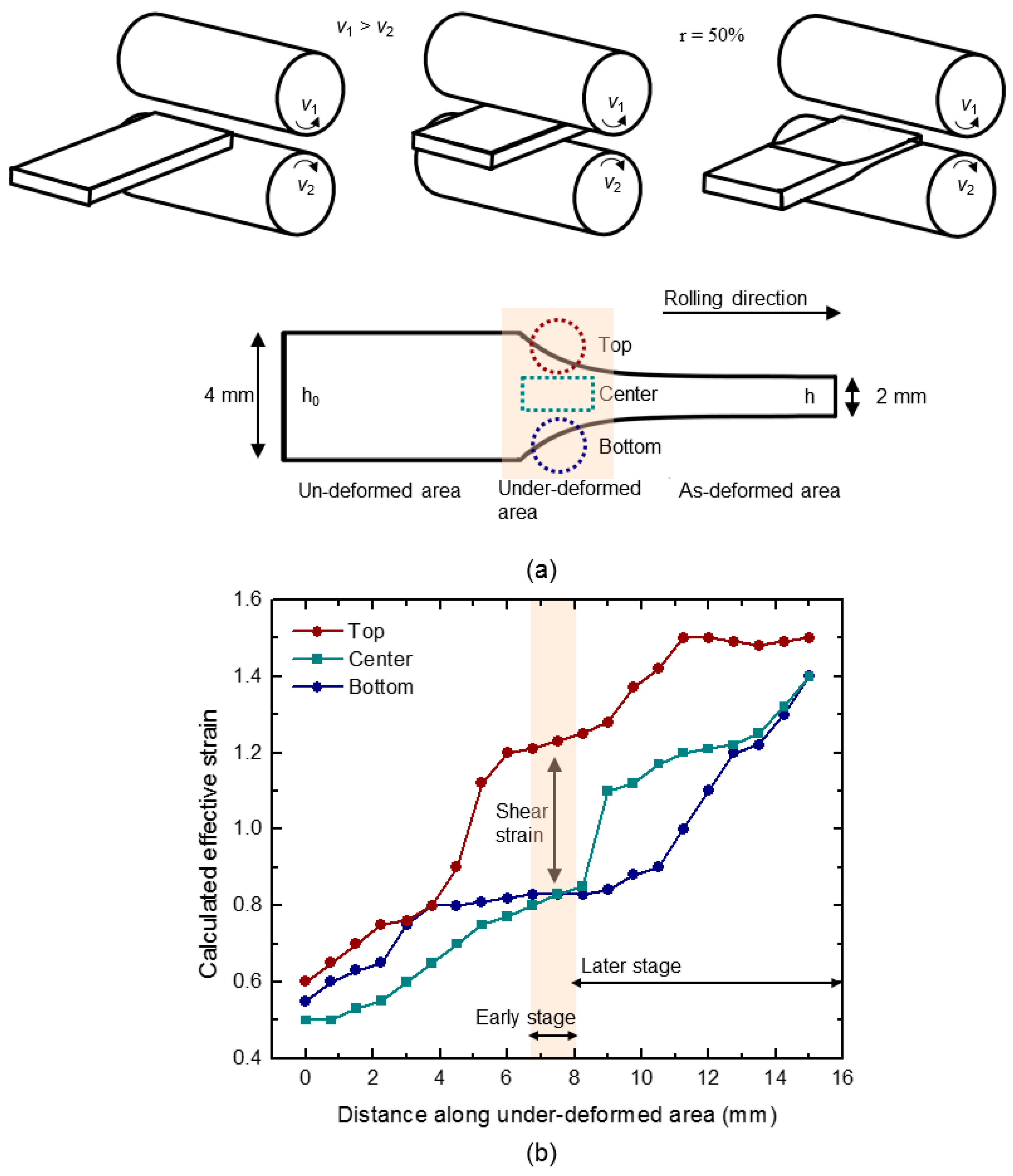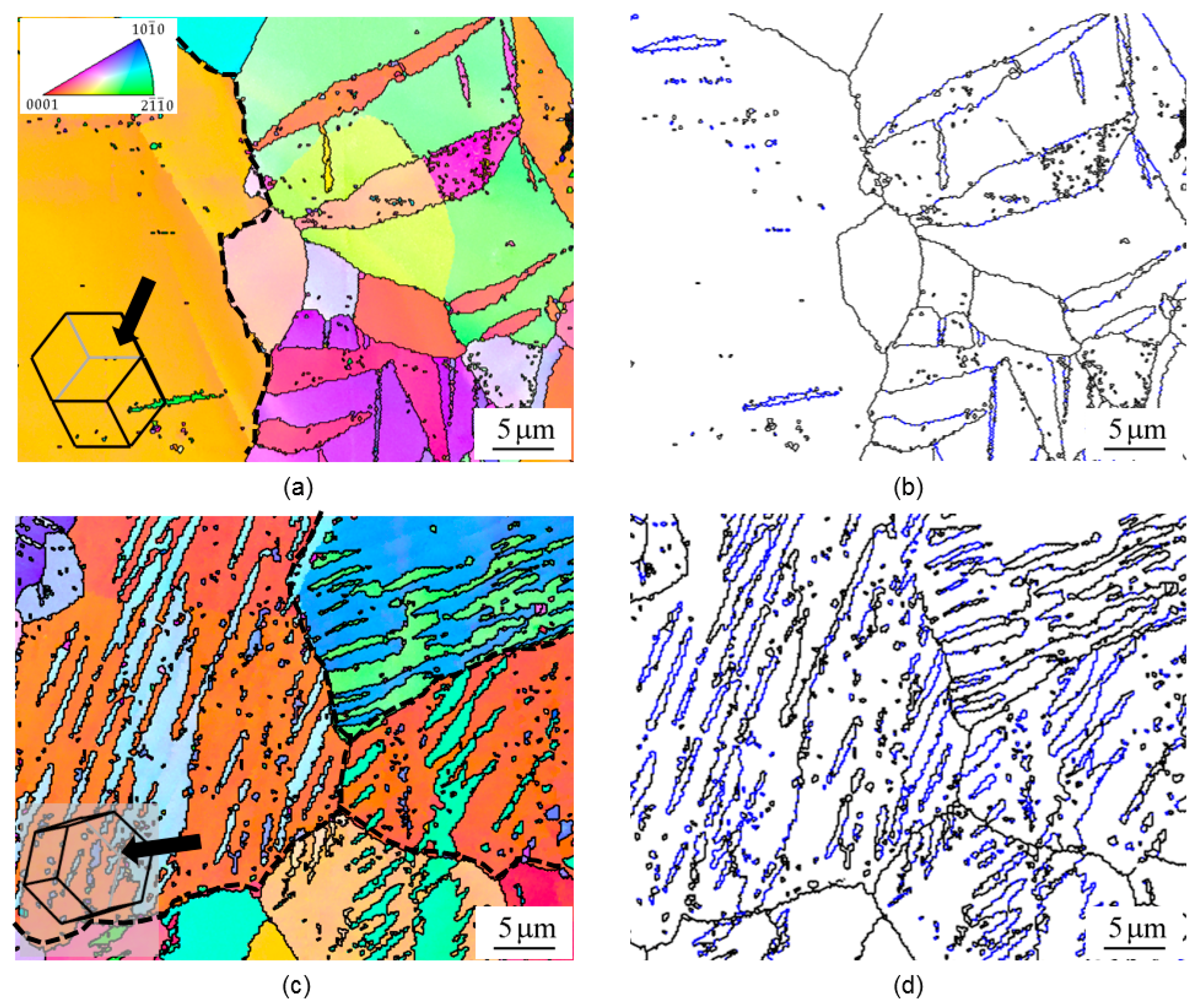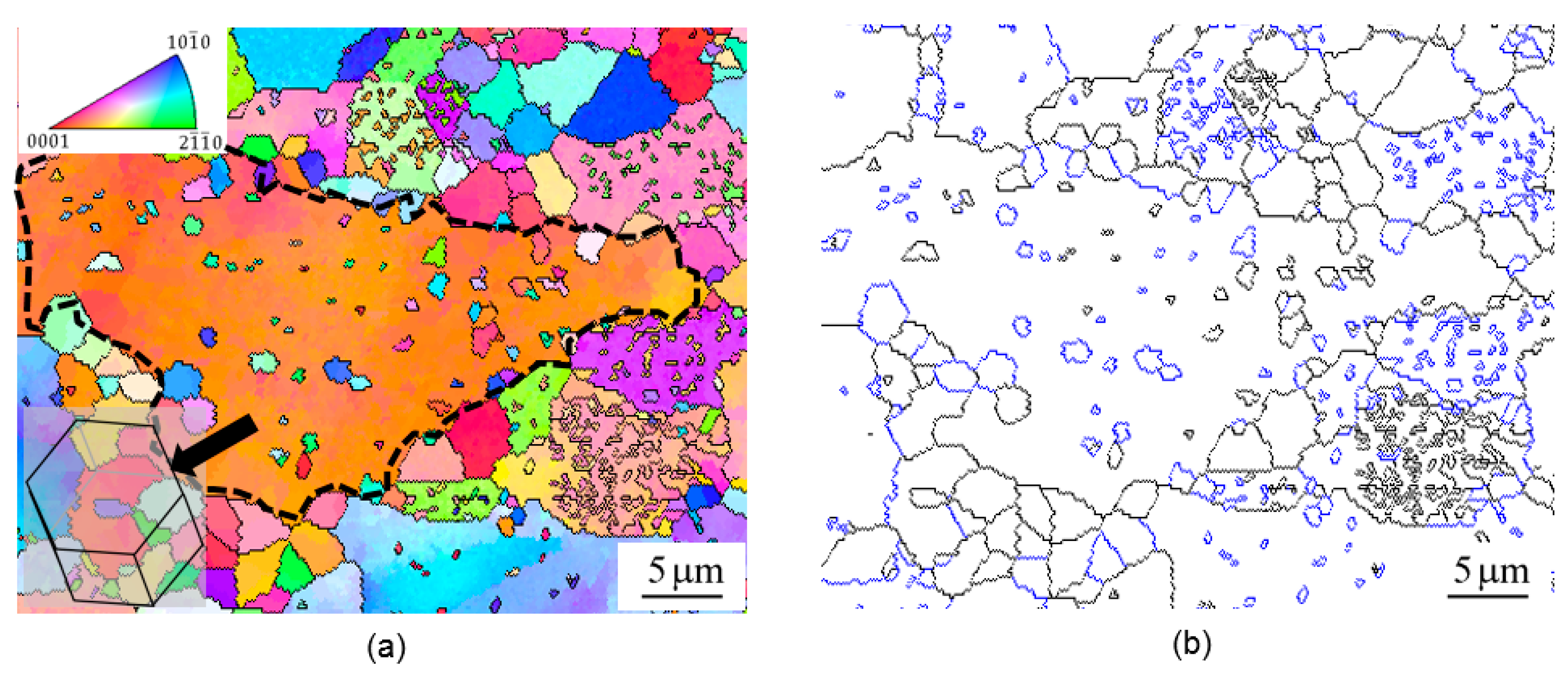Grain Refinement by Extension Twin in Mg Alloy during Asymmetrical Rolling
Abstract
:1. Introduction
2. Experimental Procedures
3. Results and Discussion
3.1. AR Deformation
3.2. Deformation Twin
3.3. Deformed Microstructure
4. Conclusions
Author Contributions
Funding
Conflicts of Interest
References
- Ko, Y.G.; Hamad, K. Structural Features and mechanical properties of AZ31 Mg Alloy warm-deformed by differential speed rolling. J. Alloy. Compd. 2018, 744, 96–103. [Google Scholar] [CrossRef]
- Hamad, K.; Ko, Y.G. A cross-shear deformation for optimizing the strength and ductility of AZ31 magnesium alloys. Sci. Rep. 2016, 6, 29954. [Google Scholar] [CrossRef] [PubMed] [Green Version]
- Ko, Y.G.; Hamad, K. Microstructure stability and mechanical properties of ultrafine grained 5052 Al alloy fabricated by differential speed rolling. Mater. Sci. Eng. A 2018, 733, 24–27. [Google Scholar] [CrossRef]
- Yang, H.W.; Widiantara, I.P.; Ko, Y.G. Effect of deformation path on texture and tension properties of submicrocrystalline Al-Mg-Si alloy fabricated by differential speed rolling. Mater. Lett. 2018, 213, 54–57. [Google Scholar] [CrossRef]
- Tian, L.; Li, L. A review on the strengthening of nanostructured materials. Int. J. Curr. Eng. Technol. 2018, 88, 236–249. [Google Scholar] [CrossRef]
- Ko, Y.G.; Shin, D.H.; Park, K.T.; Lee, C.S. An analysis of the strain hardening behavior of ultra-fine grain pure titanium. Scr. Mater. 2006, 54, 1785–1789. [Google Scholar] [CrossRef]
- Ko, Y.G.; Hamad, K. On the microstructure homogeneity of AA6061 alloy after cross-shear deformations. Adv. Eng. Mater. 2017, 19, 1700152. [Google Scholar] [CrossRef]
- Ko, Y.G.; Widiantara, I.P.; Hamad, K. On the considerability of DSR (differential speed rolling) as a severe plastic deformation method. Adv. Eng. Mater. 2017, 19, 1–5. [Google Scholar] [CrossRef]
- Ko, Y.G.; Hamad, K. Annealing behavior of 6061 Al alloy subjected to differential speed rolling deformation. Metals 2017, 7, 494. [Google Scholar] [CrossRef]
- Hilšer, O.; Rusz, S.; Szkandera, P.; Čížek, L.; Kraus, M.; Džugan, J.; Maziarz, W. Study of the microstructure, tensile properties and hardness of AZ61 magnesium alloy subjected to severe plastic deformation. Metals 2018, 8, 776. [Google Scholar] [CrossRef]
- Gong, X.; Kang, S.B.; Li, S.; Cho, J.H. Enhanced plasticity of twin-roll cast ZK60 magnesium alloy through differential speed rolling. Mater. Des. 2009, 30, 3345–3350. [Google Scholar] [CrossRef]
- Kim, H.K.; Cho, J.H.; Kim, H.W.; Lee, J.C. 6xxx series al alloy sheets with high formability produced by twin-roll strip casting and asymmetric rolling. J. Korean Inst. Met. Mater. 2012, 50, 503–509. [Google Scholar]
- Wu, H.C.; Kumar, A.; Wang, J.; Bi, X.F.; Tomé, C.N.; Zhang, Z.; Mao, S.X. Rolling-induced face centered cubic titanium in hexagonal close packed titanium at room temperature. Sci. Rep. 2016, 6, 1–8. [Google Scholar] [CrossRef] [PubMed]
- Cui, Q.; Ohori, K. Grain refinement of high purity aluminium by asymmetric rolling. Mater. Sci. Technol. 2000, 16, 1095–1101. [Google Scholar] [CrossRef]
- Park, J.H.; Hamad, K.; Widiantara, I.P.; Ko, Y.G. Strain and crystallographic texture evaluation of interstitial free steel cold deformed by differential speed rolling. Mater. Lett. 2015, 147, 38–41. [Google Scholar] [CrossRef]
- Hamad, K.; Park, J.H.; Ko, Y.G. Finite Element Analysis of Deformation Behavior in Al-2.2 wt.%Mg Alloy Subjected to Differential Speed Rolling. J. Mater. Eng. Perform. 2015, 24, 2990–3001. [Google Scholar] [CrossRef]
- Barnett, M.R.; Nave, M.D.; Ghaderi, A. Yield point elongation due to twinning in a magnesium alloy. Acta Mater. 2012, 60, 1433–1443. [Google Scholar] [CrossRef]
- Barnett, M.R.; Keshavarz, Z.; Nave, M.D. Microstructural features of rolled Mg-3Al-Zn. Met. Mater. Trans. A 2005, 36, 1697–1704. [Google Scholar] [CrossRef]
- Nave, M.D.; Barnett, M.R. Microstructures and textures of pure magnesium deformed in plane-strain compression. Scr. Mater. 2004, 51, 881–885. [Google Scholar] [CrossRef]
- Cui, Y.; Li, Y.; Sun, S.; Bian, H.; Huang, H.; Wang, Z.; Koizumi, Y.; Chiba, A. Enhanced damping capacity of magnesium alloys by tensile twin boundaries. Scr. Mater. 2015, 101, 8–11. [Google Scholar] [CrossRef]
- Ma, E.; Wang, Y.M.; Lu, Q.H.; Sui, M.L.; Lu, L.; Lu, K. Strain hardening and large tensile elongation in ultrahigh-strength nano-twinned copper. Appl. Phys. Lett. 2004, 85, 4932–4934. [Google Scholar] [CrossRef]
- Fan, H.; Aubry, S.; Arsenlis, A.; El-Awady, J.A. The role of twinning deformation on the hardening response of polycrystalline magnesium from discrete dislocation dynamics simulations. Acta Mater. 2015, 92, 126–139. [Google Scholar] [CrossRef] [Green Version]
- Jonas, J.J.; Mu, S.; Al-Samman, T.; Gottstein, G.; Jiang, L.; Martin, E. The role of strain accommodation during the variant selection of primary twins in magnesium. Acta Mater. 2011, 59, 2046–2056. [Google Scholar] [CrossRef]






© 2018 by the authors. Licensee MDPI, Basel, Switzerland. This article is an open access article distributed under the terms and conditions of the Creative Commons Attribution (CC BY) license (http://creativecommons.org/licenses/by/4.0/).
Share and Cite
Widiantara, I.P.; Yang, H.W.; Kamil, M.P.; Yoon, D.K.; Ko, Y.G. Grain Refinement by Extension Twin in Mg Alloy during Asymmetrical Rolling. Metals 2018, 8, 891. https://doi.org/10.3390/met8110891
Widiantara IP, Yang HW, Kamil MP, Yoon DK, Ko YG. Grain Refinement by Extension Twin in Mg Alloy during Asymmetrical Rolling. Metals. 2018; 8(11):891. https://doi.org/10.3390/met8110891
Chicago/Turabian StyleWidiantara, I Putu, Hae Woong Yang, Muhammad Prisla Kamil, Dong Keun Yoon, and Young Gun Ko. 2018. "Grain Refinement by Extension Twin in Mg Alloy during Asymmetrical Rolling" Metals 8, no. 11: 891. https://doi.org/10.3390/met8110891



